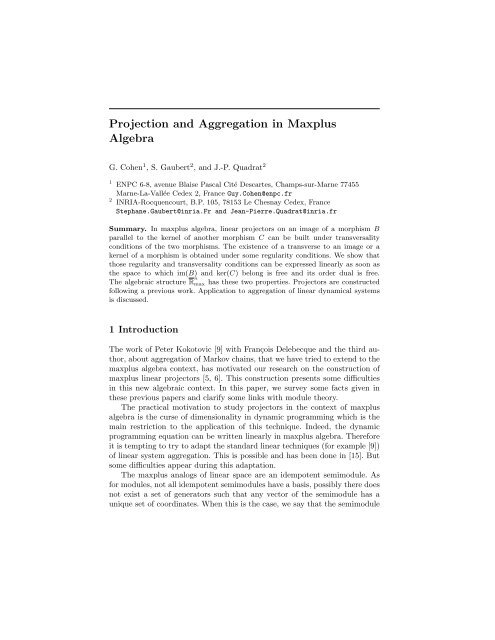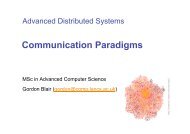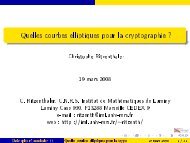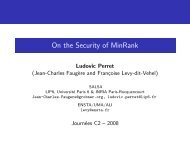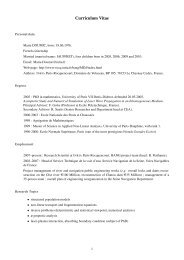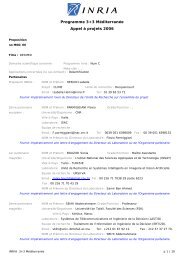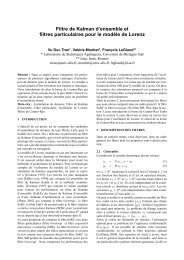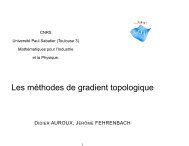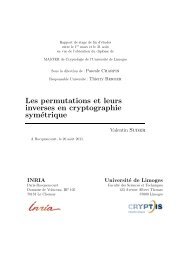Projection and Aggregation in Maxplus Algebra - Jean-Pierre ...
Projection and Aggregation in Maxplus Algebra - Jean-Pierre ...
Projection and Aggregation in Maxplus Algebra - Jean-Pierre ...
You also want an ePaper? Increase the reach of your titles
YUMPU automatically turns print PDFs into web optimized ePapers that Google loves.
<strong>Projection</strong> <strong>and</strong> <strong>Aggregation</strong> <strong>in</strong> <strong>Maxplus</strong><br />
<strong>Algebra</strong><br />
G. Cohen 1 , S. Gaubert 2 , <strong>and</strong> J.-P. Quadrat 2<br />
1 ENPC 6-8, avenue Blaise Pascal Cité Descartes, Champs-sur-Marne 77455<br />
Marne-La-Vallée Cedex 2, France Guy.Cohen@enpc.fr<br />
2 INRIA-Rocquencourt, B.P. 105, 78153 Le Chesnay Cedex, France<br />
Stephane.Gaubert@<strong>in</strong>ria.Fr <strong>and</strong> <strong>Jean</strong>-<strong>Pierre</strong>.Quadrat@<strong>in</strong>ria.fr<br />
Summary. In maxplus algebra, l<strong>in</strong>ear projectors on an image of a morphism B<br />
parallel to the kernel of another morphism C can be built under transversality<br />
conditions of the two morphisms. The existence of a transverse to an image or a<br />
kernel of a morphism is obta<strong>in</strong>ed under some regularity conditions. We show that<br />
those regularity <strong>and</strong> transversality conditions can be expressed l<strong>in</strong>early as soon as<br />
the space to which im(B) <strong>and</strong> ker(C) belong is free <strong>and</strong> its order dual is free.<br />
The algebraic structure R n max has these two properties. Projectors are constructed<br />
follow<strong>in</strong>g a previous work. Application to aggregation of l<strong>in</strong>ear dynamical systems<br />
is discussed.<br />
1 Introduction<br />
The work of Peter Kokotovic [9] with François Delebecque <strong>and</strong> the third author,<br />
about aggregation of Markov cha<strong>in</strong>s, that we have tried to extend to the<br />
maxplus algebra context, has motivated our research on the construction of<br />
maxplus l<strong>in</strong>ear projectors [5, 6]. This construction presents some difficulties<br />
<strong>in</strong> this new algebraic context. In this paper, we survey some facts given <strong>in</strong><br />
these previous papers <strong>and</strong> clarify some l<strong>in</strong>ks with module theory.<br />
The practical motivation to study projectors <strong>in</strong> the context of maxplus<br />
algebra is the curse of dimensionality <strong>in</strong> dynamic programm<strong>in</strong>g which is the<br />
ma<strong>in</strong> restriction to the application of this technique. Indeed, the dynamic<br />
programm<strong>in</strong>g equation can be written l<strong>in</strong>early <strong>in</strong> maxplus algebra. Therefore<br />
it is tempt<strong>in</strong>g to try to adapt the st<strong>and</strong>ard l<strong>in</strong>ear techniques (for example [9])<br />
of l<strong>in</strong>ear system aggregation. This is possible <strong>and</strong> has been done <strong>in</strong> [15]. But<br />
some difficulties appear dur<strong>in</strong>g this adaptation.<br />
The maxplus analogs of l<strong>in</strong>ear space are an idempotent semimodule. As<br />
for modules, not all idempotent semimodules have a basis, possibly there does<br />
not exist a set of generators such that any vector of the semimodule has a<br />
unique set of coord<strong>in</strong>ates. When this is the case, we say that the semimodule
2 G. Cohen, S. Gaubert, <strong>and</strong> J.-P. Quadrat<br />
is free. Moreover, like <strong>in</strong> module theory, any surjective l<strong>in</strong>ear operator does<br />
not admit a l<strong>in</strong>ear <strong>in</strong>verse, when this is the case, the range space is called<br />
projective; dually when any <strong>in</strong>jective l<strong>in</strong>ear application admits a l<strong>in</strong>ear <strong>in</strong>verse,<br />
we say that the doma<strong>in</strong> is <strong>in</strong>jective. To be able to build the analog of a l<strong>in</strong>ear<br />
projector on an image parallel to a kernel, we need a transversality condition<br />
that is the existence <strong>and</strong> uniqueness of the <strong>in</strong>tersection of the kernel <strong>and</strong> the<br />
image (more precisely, the kernel <strong>in</strong>troduced <strong>in</strong> the follow<strong>in</strong>g def<strong>in</strong>es a fibration<br />
<strong>and</strong> transversality means that each kernel fiber always <strong>in</strong>tersects the image<br />
<strong>in</strong> a unique po<strong>in</strong>t). The transversality condition can be checked by means<br />
of l<strong>in</strong>ear algebra as soon as the ambient semimodule has some properties of<br />
projectiveness <strong>and</strong> <strong>in</strong>jectiveness.<br />
In a previous work [6], we have obta<strong>in</strong>ed necessary <strong>and</strong> sufficient conditions<br />
for the existence of a l<strong>in</strong>ear projector but the l<strong>in</strong>ks with module theory were<br />
not given. In the present paper, we extend this result us<strong>in</strong>g assumptions of<br />
freeness on the ambient space <strong>and</strong> its order dual. This dual space is no longer<br />
def<strong>in</strong>ed as the set of cont<strong>in</strong>uous l<strong>in</strong>ear forms but it is rather derived from the<br />
def<strong>in</strong>ition of a scalar product us<strong>in</strong>g residuation. So do<strong>in</strong>g, the bidual space is<br />
equal to the <strong>in</strong>itial space. Apart from this improvement of the assumptions,<br />
the construction of the l<strong>in</strong>ear projector is the same <strong>and</strong> is recalled here.<br />
There exist few works on these questions. We can f<strong>in</strong>d some results on<br />
semimodules <strong>in</strong> [10, 16]. The application of l<strong>in</strong>ear projection to aggregation<br />
<strong>and</strong> coherency has been studied <strong>in</strong> [15]. We recall here some of these results,<br />
<strong>in</strong> particular, the notion of lumpability of dynamic programm<strong>in</strong>g equations.<br />
2 Ordered <strong>Algebra</strong>ic Structures<br />
2.1 Structure Def<strong>in</strong>itions<br />
A semir<strong>in</strong>g is a set D equipped with two operations ⊕ <strong>and</strong> ⊗ such that: (D, ⊕)<br />
is a commutative monoid whose zero is denoted by ɛ, (D, ⊗) is a monoid whose<br />
unit is denoted by e, ⊗ is distributive with respect to ⊕, the zero is absorb<strong>in</strong>g,<br />
that is ɛ ⊗ a = a ⊗ ɛ = ɛ. A dioid is an idempotent semir<strong>in</strong>g: a ⊕ a = a. A<br />
semifield is a semir<strong>in</strong>g <strong>in</strong> which nonzero elements have an <strong>in</strong>verse.<br />
Example 1. The maxplus semifield R max is the set R ∪ {−∞} equipped with<br />
⊕ = max <strong>and</strong> ⊗ = +. It is an idempotent semifield. .<br />
A semimodule is the analogue of a module but def<strong>in</strong>ed on a semir<strong>in</strong>g<br />
<strong>in</strong>stead of a r<strong>in</strong>g.<br />
Example 2. R n max is an idempotent semimodule.<br />
Example 3. The set of n × n matrices with entries <strong>in</strong> R max is a dioid for the<br />
operations:<br />
(A ⊗ B) ik = max{A ij + B jk }, (A ⊕ B) ij = max{A ij , B ij } .<br />
j
<strong>Projection</strong> <strong>and</strong> <strong>Aggregation</strong> <strong>in</strong> <strong>Maxplus</strong> <strong>Algebra</strong> 3<br />
In a dioid, the operation ⊕ <strong>in</strong>duces an order relation: a ≥ b ⇐⇒ a =<br />
a ⊕ b, ∀a, b ∈ D. Then a ∨ b = a ⊕ b. We say that a dioid D is complete if any<br />
arbitrary subset B ⊂ D has a supremum <strong>and</strong> if the product distributes with<br />
respect to suprema. When the supremum of a set B belongs to B we denote<br />
it by ⊤B.<br />
Example 4. R max is not complete but R max = R max ∪ {+∞} is complete.<br />
A complete dioid is a complete lattice. Indeed we can def<strong>in</strong>e the <strong>in</strong>fimum<br />
of a set A ⊂ D by ⊤{d ∈ D | d ≤ a, ∀a ∈ A}. When the <strong>in</strong>fimum of A belongs<br />
to A, we denote it by ⊥A.<br />
2.2 Residuated Mapp<strong>in</strong>gs<br />
If D <strong>and</strong> C are complete lattices, we say that a map f : D → C is isotone if<br />
a b implies f (a) f (b). We say that f is lower semicont<strong>in</strong>uous (lsc) if f<br />
commutes with arbitrary suprema. We say that f is residuated if the maximal<br />
element f ♯ (y)⊤ {x ∈ D : f (x) y} exists for all y ∈ C. The function f ♯ is<br />
called the residual of f. We say that a map g : C ↦→ D is dually residuated if<br />
g ♭ (x)⊥ {y ∈ C : g (y) x} exists for all x ∈ C.<br />
It is shown <strong>in</strong> [1] that f is residuated iff f is lsc with f(ɛ) = ɛ. Moreover,<br />
f is residuated iff f is isotone <strong>and</strong> there exists an isotone map g : C → D such<br />
that: f ◦ g I C <strong>and</strong> g ◦ f I D .<br />
The residual has the follow<strong>in</strong>g properties: f ◦ f ♯ ◦ f = f; f ♯ ◦ f ◦ f ♯ = f ♯ ;<br />
f is <strong>in</strong>jective iff f ♯ ◦ f = I D iff f ♯ is surjective; f is surjective iff f ◦ f ♯ = I C<br />
iff f ♯ is <strong>in</strong>jective; (h ◦ f) ♯ = f ♯ ◦ h ♯ ; f g iff g ♯ f ♯ ; (f ⊕ g) ♯ = f ♯ ∧ g ♯ ;<br />
(<br />
f ♯ ∧ g ♯) ♭<br />
= f ⊕ g.<br />
Example 5. The function f : x ∈ R 2 max ↦→ x 1 ∧ x 2 ∈ R max is isotone but not<br />
residuated. The function f : x ∈ R 2 max ↦→ x 2 1 ⊕ x 2 2 max (2x 1 , 2x 2 ) ∈ R max is<br />
isotone, additive but nonl<strong>in</strong>ear <strong>and</strong> residuated.<br />
x<br />
2 2<br />
x<br />
y<br />
y/2<br />
y<br />
x<br />
1<br />
y/2<br />
x<br />
1<br />
Fig. 1. x 1 ∧ x 2 ≤ y <strong>and</strong> x 2 1 ⊕ x 2 2 ≤ y.
4 G. Cohen, S. Gaubert, <strong>and</strong> J.-P. Quadrat<br />
Example 6. If A is a m × n matrix with entries <strong>in</strong> R max , the morphism x ∈<br />
R m max ↦→ Ax ∈ R n max is residuated: the maximal element of the set {x ∈ R n max |<br />
Ax b} exists, it is denoted A\b with (A\b) j = ∧ A ij \b i . Indeed:<br />
i<br />
Ax b ⇔ ⊕ j<br />
A ij x j b i , ∀j ⇔ A ij x j b i , ∀i, j<br />
⇔ x j A ij \b i , ∀i, j ⇔ x j ∧ i<br />
A ij \b i , ∀j .<br />
Thus A\b = (−A t ) ⊙ b where ⊙ denotes the m<strong>in</strong>plus matrix product. In the<br />
same way, we can compute A\B, B/A, C\A/B for matrices with compatible<br />
dimensions.<br />
For example A\B is the largest matrix such that AX ≤ B <strong>and</strong>, if there<br />
exists X such that AX = B, we have A(A\B) = B. Moreover B ↦→ A\B is<br />
an ∧ morphism.<br />
3 Idempotent Semimodules<br />
In this section we extend the notion of projective module <strong>and</strong> <strong>in</strong>jective module<br />
to projective <strong>and</strong> <strong>in</strong>jective idempotent semimodule.<br />
3.1 Projective Idempotent Semimodules<br />
Def<strong>in</strong>ition 1. A complete idempotent semimodule P is projective if for all<br />
complete idempotent semimodules U <strong>and</strong> X <strong>and</strong> for all morphisms A : P → X<br />
<strong>and</strong> B : U → X such that im(A) ⊂ im(B) there exists a morphism R : P → U<br />
such that A = BR.<br />
This is of course the analog of the classical notion <strong>in</strong> module theory. The<br />
follow<strong>in</strong>g proposition shows that free complete idempotent semimodules are<br />
projective <strong>and</strong> the factor R can be computed by residuation.<br />
Proposition 1. Given the free idempotent complete semimodule P, the two<br />
idempotent complete semimodules U, X , the morphism B : U → X <strong>and</strong> the<br />
morphism A : P → X such that im(A) ⊂ im(B), we have:<br />
A = B(B\A) . (1)<br />
The existence of a morphism R such that A = BR follows from the classical<br />
argument [1, Th. 8.6] The maximal R is equal to (B\A). In the case of matrices<br />
(B\A) has been computed as <strong>in</strong> Example 6.<br />
[ ]<br />
Example 7. X = im(B) subsemimodule of R 2 1 e<br />
max with B = is not free.<br />
e 1
<strong>Projection</strong> <strong>and</strong> <strong>Aggregation</strong> <strong>in</strong> <strong>Maxplus</strong> <strong>Algebra</strong> 5<br />
[ [ [ 1 1 e<br />
The vector can also be written ⊕ (−1) <strong>and</strong> therefore has not<br />
e]<br />
e]<br />
1]<br />
{[ [ 1 e<br />
a unique set of coord<strong>in</strong>ates on the generat<strong>in</strong>g family , . However,<br />
e]<br />
1]}<br />
im(B) is projective because B has [ a generalized ] <strong>in</strong>verse B g , mean<strong>in</strong>g that<br />
−1 −2<br />
BB g B = B. We can take: B g = .<br />
−2 −1<br />
3.2 Injective Idempotent Semimodules<br />
To discuss <strong>in</strong>jective idempotent semimodules, it is necessary to extend the<br />
notion of morphism kernel. Indeed, s<strong>in</strong>ce <strong>in</strong> a semir<strong>in</strong>g the general l<strong>in</strong>ear equation<br />
Ax = A ′ x cannot be reduced to A ′′ x = ɛ, the st<strong>and</strong>ard kernel def<strong>in</strong>ition<br />
is not very useful. Instead, we <strong>in</strong>troduce the fibration of the doma<strong>in</strong> by the<br />
<strong>in</strong>jectivity classes of a morphism.<br />
Def<strong>in</strong>ition 2. Given two semimodules X <strong>and</strong> Y <strong>and</strong> a morphism C : X → Y,<br />
we def<strong>in</strong>e the equivalence relation ker(C) on X by x ∼ x ′ modulo ker(C) if<br />
Cx = Cx ′ .<br />
We say that ker(C) ⊂ ker(A) when the fibration <strong>in</strong>duced by ker(C) is a<br />
subfibration of that of ker(A), that is, when Cx = Cx ′ implies Ax = Ax ′ .<br />
With this kernel def<strong>in</strong>ition, we can extend the notion of <strong>in</strong>jective modules to<br />
<strong>in</strong>jective semimodules.<br />
Def<strong>in</strong>ition 3. A complete idempotent semimodule I is <strong>in</strong>jective if for all complete<br />
idempotent semimodules Y <strong>and</strong> X <strong>and</strong> for all morphisms A : X → I <strong>and</strong><br />
C : X → Y satisfy<strong>in</strong>g ker(C) ⊂ ker(A) there exists a morphism L : Y → I<br />
such that A = LC.<br />
To underst<strong>and</strong> the duality between projective <strong>and</strong> <strong>in</strong>jective idempotent<br />
semimodules, it is useful to <strong>in</strong>troduce a duality on idempotent semimodules<br />
based on residuation.<br />
If X is a complete idempotent semimodule on the idempotent semir<strong>in</strong>g D,<br />
we call (order) dual of X , the semimodule on the semir<strong>in</strong>g D, denoted X ♯ ,<br />
with underly<strong>in</strong>g set X , addition (x ∈ X , x ′ ∈ X ) ↦→ (x ∧ x ′ ) ∈ X (where ∧ is<br />
relative to the natural order on X <strong>in</strong>duced by ⊕) <strong>and</strong> action (λ ∈ D, x ∈ X ) ↦→<br />
x/λ ∈ X . The semimodule property of X ♯ comes easily from the residuation<br />
properties.<br />
Proposition 2 ([7] Prop. 4). For all complete idempotent semimodules X ,<br />
(X ♯ ) ♯ = X .<br />
Associated with a semimodule morphism C : X → Y, the residuation<br />
operation def<strong>in</strong>es the semimodule morphism C ♯ : Y ♯ → X ♯ with which we can<br />
characterize the kernel <strong>in</strong>clusions.
6 G. Cohen, S. Gaubert, <strong>and</strong> J.-P. Quadrat<br />
Proposition 3. Given two idempotent complete semimodules X , Y, two morphisms<br />
A <strong>and</strong> C from X to Y, we have:<br />
ker(C) ⊂ ker(A) ⇔ im(A ♯ ) ⊂ im(C ♯ ) .<br />
Proof. If im(A ♯ ) ⊂ im(C ♯ ), any po<strong>in</strong>t <strong>in</strong> im(A ♯ ) does not move when projected<br />
on im(C ♯ ), which translates <strong>in</strong>to the equality C ♯ CA ♯ = A ♯ . By pre- <strong>and</strong> postcomposition<br />
with A of both sides of this equality, one gets that<br />
AC ♯ CA ♯ A = AA ♯ A = A .<br />
We have AC ♯ CA ♯ A ≥ AC ♯ C ≥ A because both A ♯ A <strong>and</strong> C ♯ C are greater<br />
than the identity. F<strong>in</strong>ally, equality holds throughout <strong>and</strong> we have proved that<br />
A = AC ♯ C, from which it is clear that ker(C) ⊂ ker(A).<br />
Conversely, it is easily checked that C ♯ Cx is equivalent to x modulo ker(C).<br />
Mov<strong>in</strong>g <strong>in</strong> the same class modulo ker(C) implies mov<strong>in</strong>g <strong>in</strong> the same class<br />
modulo ker(A) from the assumption. Therefore A = AC ♯ C. Then, pre <strong>and</strong><br />
post-composition with A ♯ shows that<br />
A ♯ AC ♯ CA ♯ = A ♯ AA ♯ = A ♯<br />
<strong>and</strong> A ♯ AC ♯ CA ♯ ≥ C ♯ CA ♯ ≥ A ♯ which shows that equality holds throughout.<br />
Therefore A ♯ = C ♯ CA ♯ which shows that im(A ♯ ) ⊂ im(C ♯ ).<br />
Theorem 1. An idempotent complete semimodule is <strong>in</strong>jective if <strong>and</strong> only if<br />
its (order) dual is projective.<br />
Proof. If I ♯ is projective <strong>and</strong> the morphisms A : X → I <strong>and</strong> C : X → Y<br />
satisfy ker(C) ⊂ ker(A) then im(A ♯ ) ⊂ im(C ♯ ) <strong>and</strong> because I ♯ is projective<br />
there exists a morphism L ♯ : I ♯ → X ♯ such that A ♯ = C ♯ L ♯ which implies<br />
A = LC thanks to the residuation properties.<br />
Conversely, if I is <strong>in</strong>jective, consider the morphisms A ♯ : I ♯ → X ♯ <strong>and</strong><br />
C ♯ : X ♯ → Y ♯ such that im(A ♯ ) ⊂ im(C ♯ ) which implies ker(C) ⊂ ker(A)<br />
which implies A = LC s<strong>in</strong>ce I is <strong>in</strong>jective <strong>and</strong> therefore A ♯ = C ♯ L ♯ which<br />
shows that I ♯ is projective.<br />
Proposition 4. Given a complete idempotent semimodule I with a free dual,<br />
two complete idempotent semimodules Y, X <strong>and</strong> two morphisms A : X → I,<br />
C : X → Y with ker(C) ⊂ ker(A) we have:<br />
A = (A/C)C . (2)<br />
It is useful to remark that the dual of a free semimodule is not always free.<br />
Example 8. R n max is free <strong>and</strong> its dual R n m<strong>in</strong> is free <strong>and</strong> therefore these two<br />
semimodules are projective <strong>and</strong> <strong>in</strong>jective.<br />
Example 9. R + max = (R + ∪{−∞, +∞}, max, +) is a complete idempotent semimodule<br />
on R + max which is free, its basis is {0}, but its dual is not free.
<strong>Projection</strong> <strong>and</strong> <strong>Aggregation</strong> <strong>in</strong> <strong>Maxplus</strong> <strong>Algebra</strong> 7<br />
4 Projectors<br />
In the follow<strong>in</strong>g, the sets U, X <strong>and</strong> Y will be complete idempotent semimodules.<br />
Moreover, we will suppose that X <strong>and</strong> its dual are free so that we can<br />
test the image or kernel <strong>in</strong>clusions by (1) or (2). Based on those assumptions,<br />
follow<strong>in</strong>g [6], we build l<strong>in</strong>ear projectors on subsemimodules of X that can be<br />
described as images of regular morphisms.<br />
We say that B is regular if there exists a generalized <strong>in</strong>verse B g satisfy<strong>in</strong>g:<br />
B = BB g B. Then there exists a largest generalized <strong>in</strong>verse equal to B\B/B.<br />
Therefore we have:<br />
B = B(B\B/B)B (3)<br />
if <strong>and</strong> only if B is regular. Indeed, the existence of B g implies the existence<br />
of X such that B = BXB <strong>and</strong> therefore the largest X such that B ≥ BXB<br />
(which is equal to B\B/B) satisfies the equality.<br />
Moreover, with every generalized <strong>in</strong>verse, we can associate a generalized<br />
reflexive <strong>in</strong>verse. Indeed, B r BB g B is an <strong>in</strong>verse that satisfies<br />
B = BB r B, B r = B r BB r ,<br />
which are the relations which def<strong>in</strong>e the reflexive <strong>in</strong>verses.<br />
4.1 Projector on Im(B)<br />
Proposition 5. There exists a l<strong>in</strong>ear projector Q on im(B) iff B is regular.<br />
By l<strong>in</strong>ear projector we mean a projector that is a morphism of complete<br />
idempotent semimodules.<br />
Proof. If Q is a l<strong>in</strong>ear projector on im(B), we have QB = B. S<strong>in</strong>ce B <strong>and</strong><br />
Q have the same image, by (1) we have Q = B(B\Q), which implies B =<br />
B(B\Q)B. Therefore we can take B g = B\Q as generalized <strong>in</strong>verse. Thus B<br />
is regular.<br />
Conversely if B g is a generalized <strong>in</strong>verse of B then Q = BB g is a l<strong>in</strong>ear<br />
projector on im(B).<br />
In order to prepare the transition with the next section, it is useful to give<br />
other forms to the projector Q<br />
Proposition 6. If B is regular <strong>and</strong> B r is a generalized reflexive <strong>in</strong>verse of B,<br />
we have<br />
Q = BB r = (B/(B r B))B r = B((B r B)\B r ) .<br />
Proof. From B = BB r B, we deduce from the residuation properties that<br />
B = (B/(B r B))B r B. Similarly from B r = B r BB r , we deduce B r =<br />
B r B((B r B)\B r ). Let P def<strong>in</strong>ed by P (B/(B r B))B r we have P =<br />
(B/(B r B))B r B((B r B)\B r ) = B((B r B)\B r ).
8 G. Cohen, S. Gaubert, <strong>and</strong> J.-P. Quadrat<br />
Moreover P B = B, B r P = B r <strong>and</strong> P 2 = (B/(B r B))B r B((B r B)\B r ) =<br />
(B/(B r B))B r = P , therefore P is a projector on im(B) <strong>and</strong> s<strong>in</strong>ce B r P = B r<br />
the projection is parallel to ker(B r ).<br />
F<strong>in</strong>ally: Q = BB r = (B/(B r B))B r BB r B((B r B)\B r ) = (B/(B r B))B r =<br />
P.<br />
4.2 Projector on Im(B) parallel to Ker(C)<br />
To def<strong>in</strong>e a projector on im(B) parallel to ker(C), we need a transversality<br />
condition, that is, each equivalent class of ker(C) <strong>in</strong>tersects im(B) <strong>in</strong> exactly<br />
one po<strong>in</strong>t (for all x there exists a unique x ′ such that Cx = Cx ′ with x ′ : x ′ =<br />
Bu). The follow<strong>in</strong>g theorem gives a test for transversality.<br />
Theorem 2 ([6] Th.8 <strong>and</strong> 9). The three follow<strong>in</strong>g assertions are equivalent:<br />
1. ker(CB) = ker(B) <strong>and</strong> im(CB) = im(C), that is:<br />
B = (B/(CB))CB, C = CB((CB)\C) .<br />
2. There exists a l<strong>in</strong>ear projector P on im(B) parallel to ker(C):<br />
P B = B, CP = C, P 2 = P = (B/(CB))C = B((CB)\C) .<br />
3. im(B) is transverse to ker(C).<br />
Let us only show that the first proposition implies the third one.<br />
The existence of the <strong>in</strong>tersection follows from C = CB((CB)\C), <strong>in</strong>deed<br />
Cx = CB((CB)\C)x therefore y = B((CB)\C)x belongs to im(B) <strong>and</strong> is <strong>in</strong><br />
the same ker(C)-class as x.<br />
The uniqueness of the <strong>in</strong>tersection follows from B = (B/(CB))CB, <strong>in</strong>deed:<br />
CBu = CBu ′ implies (B/(CB))CBu = (B/(CB))CBu ′ = Bu = Bu ′ .<br />
Example 10. With U = X = Y = R 2 max <strong>and</strong><br />
[ ]<br />
e −1<br />
B = C =<br />
−1 e<br />
,<br />
we have B = B/B <strong>and</strong> it follows that P = B. More generally, for any E, as<br />
soon as B = E/E we have: B = B/B = B 2 = B\B = B\B/B = B r = P .<br />
Example 11. For X = R 2 max, U = Y = R max <strong>and</strong> B <strong>and</strong> C given by:<br />
[<br />
e<br />
B = , C =<br />
e]<br />
[ e −1 ] .<br />
the projector is given <strong>in</strong> Figure 3.
<strong>Projection</strong> <strong>and</strong> <strong>Aggregation</strong> <strong>in</strong> <strong>Maxplus</strong> <strong>Algebra</strong> 9<br />
Example 1<br />
1<br />
Im B<br />
1<br />
Px<br />
x<br />
Fig. 2. <strong>Projection</strong> on im(B) parallel to ker(B).<br />
x<br />
Ker C<br />
Im B<br />
Px<br />
x<br />
Fig. 3. <strong>Projection</strong> on im(B) parallel to ker(C).<br />
Example 12. For the follow<strong>in</strong>g B<br />
⎡ ⎤<br />
a e e<br />
B = ⎣e a e⎦ .<br />
e e a<br />
We have B\B<br />
⎡<br />
B\B = ⎣ e<br />
⎤<br />
−|a| −|a|<br />
−|a| e −|a| ⎦ .<br />
−|a| −|a| e<br />
With some calculation one can show that:<br />
⎡<br />
B ♯ B ⎣ x ⎤ ⎡<br />
y⎦ = (B\B) ⎣ x ⎤ ⎡<br />
y⎦ ⊕ χ ⎣ y ∧ z ⎤<br />
x ∧ z⎦ ,<br />
z<br />
z x ∧ y<br />
where χ = e if a < e <strong>and</strong> χ = ɛ otherwise.<br />
Then we see that B ♯ B = (B\B) when a ≥ e. We can verify that the case<br />
a ≥ e is precisely the case where the matrices B are regular.<br />
Example 13. The projector shown <strong>in</strong> Figure 4 is def<strong>in</strong>ed with the follow<strong>in</strong>g B<br />
<strong>and</strong> C:
10 G. Cohen, S. Gaubert, <strong>and</strong> J.-P. Quadrat<br />
Fig. 4. <strong>Projection</strong> on im(B) parallel to ker(C) <strong>in</strong> dimension 3.<br />
⎡ ⎤<br />
0 1<br />
B = ⎣0.5 0⎦ , C =<br />
2 1<br />
[ ] 0 0 0<br />
.<br />
2 1 0<br />
We see on this example that the fiber shapes can be different. In this example,<br />
we have five k<strong>in</strong>ds of fiber hav<strong>in</strong>g three different shapes.<br />
5 <strong>Aggregation</strong> <strong>and</strong> Coherency<br />
Thanks to the projectors def<strong>in</strong>ed <strong>in</strong> the previous section, the results about<br />
aggregation <strong>and</strong> coherency given <strong>in</strong> [9] can be extended to the case of maxplus<br />
algebra. This means that the aggregation tools used <strong>in</strong> the theory of l<strong>in</strong>ear<br />
systems can be applied to aggregation of dynamic programm<strong>in</strong>g problems or<br />
Hamilton-Jacobi equations. In this section, we recall some results given <strong>in</strong> [15].<br />
Given X , a complete free idempotent semimodule with free dual, we consider<br />
the endomorphism A : X → X <strong>and</strong> the dynamic system X n+1 = AX n .<br />
We say that A is aggregable by C : X → Y (regular morphism on the idempotent<br />
complete semimodule Y) if there exists A C such that CA = A C C. Then,<br />
Y n CX n satisfies the aggregate dynamics Y n+1 = A C Y n .<br />
Proposition 7. If C is regular, A is aggregable by C iff there exists B such<br />
that the projector on im(B) parallel to ker(C) satisfies P A = P AP.<br />
Proof. S<strong>in</strong>ce C is regular, there exists B <strong>and</strong> P with P = B ((CB)\C) =<br />
(B/(CB)) C.
• Sufficiency (P A = P AP ⇒ CA = A C C):<br />
<strong>Projection</strong> <strong>and</strong> <strong>Aggregation</strong> <strong>in</strong> <strong>Maxplus</strong> <strong>Algebra</strong> 11<br />
CA = CP A = CP AP = CAP = CA (B/ ((CB))) C = [CA (B/ (CB))] C ,<br />
<strong>and</strong> we have A C = CA(B/(CB)).<br />
• Necessity (P A = P AP ⇐ CA = A C C):<br />
P A = (B/ (CB)) CA = (B/ (CB)) A C C = (B/ (CB)) A C CP<br />
= (B/ (CB)) CAP = P AP .<br />
In a similar way, we say that B, assumed regular, is coherent with A if<br />
there exists A B such that: AB = BA B . In this case, if X 0 = BU 0 , then<br />
X n = BU n is def<strong>in</strong>ed by the aggregate dynamics U n+1 = A B U n .<br />
Proposition 8. If B is regular, B is coherent with A iff there exists C such<br />
that the P projector on im(B) parallel to ker(C) satisfies: AP = P AP.<br />
To show an analogy with the lumpability of Markov cha<strong>in</strong>s [12], we can<br />
specialize the previous results to the case when C is def<strong>in</strong>ed as the characteristic<br />
function of a partition.<br />
Let us suppose that X = R n m<strong>in</strong>. Consider a partition U = {J 1 , . . . , J p } of<br />
F = {1, · · · , n} <strong>and</strong> its characteristic matrix:<br />
{<br />
e if i ∈ J,<br />
U iJ =<br />
∀i ∈ F, ∀J ∈ U .<br />
ɛ si i /∈ J,<br />
If w ∈ R n m<strong>in</strong> is a cost (which is analogous to a probability, that is if w satisfies<br />
gw = e with g a row vector with all entries equal to e) the conditional cost<br />
with respect to U is def<strong>in</strong>ed by:<br />
(<br />
w<br />
U ) = w<br />
⊕ j<br />
iJ<br />
j∈J w , ∀j, J.<br />
j<br />
Clearly we have:<br />
w U = W US −1 , with S U t W U, W = diag(w) .<br />
If A is the transition cost of a Bellman cha<strong>in</strong> (that is gA = g), we say that<br />
A is U-lumpable if A is aggregable with C = U t .<br />
If A admits a unique <strong>in</strong>variant cost Aw = w, <strong>and</strong> if A is U-lumpable, we<br />
can take P = BC with B = w U for projection on im(B) parallel to ker(C)<br />
s<strong>in</strong>ce CB = U t W US −1 = SS −1 = I (the identity matrix I is the matrix with<br />
a diagonal of e <strong>and</strong> ɛ elsewhere).<br />
In this case, look<strong>in</strong>g at the mean<strong>in</strong>g of CA = A C C, we have:<br />
Proposition 9 ([15] Th.20). A is lumpable iff:<br />
⊕<br />
a kj = a KJ , ∀j ∈ J, ∀J, K ∈ U .<br />
k∈K
12 G. Cohen, S. Gaubert, <strong>and</strong> J.-P. Quadrat<br />
References<br />
1. T.S. BLYTH (1990), Module theory. Oxford Science Publications.<br />
2. T.S. BLYTH, M.J JANOWITZ (1972), Residuation theory. Pergamon Press,<br />
Oxford.<br />
3. Z.Q. CAO, K.H. KIM, F.W. ROUSH (1984), Incl<strong>in</strong>e <strong>Algebra</strong> <strong>and</strong> Applications,<br />
Hellis Horwood.<br />
4. F. BACCELLI, G. COHEN, G.J. OLSDER, <strong>and</strong> J.-P.<br />
QUADRAT (1992), Synchronization <strong>and</strong> L<strong>in</strong>earity, Wiley <strong>and</strong><br />
http://www-rocq.<strong>in</strong>ria.fr/metalau/cohen/SED/book-onl<strong>in</strong>e.html .<br />
5. G. COHEN, S. GAUBERT, J.P. QUADRAT (1996), Kernels, images<br />
<strong>and</strong> projections <strong>in</strong> dioids. Proceed<strong>in</strong>gs of WODES’96, Ed<strong>in</strong>burgh <strong>and</strong><br />
http://www-rocq.<strong>in</strong>ria.fr/metalau/quadrat/kernel.pdf .<br />
6. G. COHEN, S. GAUBERT, J.P. QUADRAT (1997). L<strong>in</strong>ear Projectors <strong>in</strong><br />
the max-plus algebra, 5th IEEE-Mediterranean Conf. Paphos, Cyprus <strong>and</strong><br />
http://www-rocq.<strong>in</strong>ria.fr/metalau/quadrat/projector.pdf .<br />
7. G. COHEN, S. GAUBERT, J.P. QUADRAT (2004), Duality <strong>and</strong> Separation<br />
Theorems <strong>in</strong> idempotent Semimodules, L<strong>in</strong>ear <strong>Algebra</strong> <strong>and</strong> its Applications N.<br />
379 pp. 395-422 <strong>and</strong> arXiv:math.FA/0212294.<br />
8. R.A. CUNNINGHAME-GREEN (1979), M<strong>in</strong>imax <strong>Algebra</strong>s. L.N. <strong>in</strong> Economics<br />
<strong>and</strong> Math. Systems, Spr<strong>in</strong>ger Verlag.<br />
9. F. DELEBECQUE, P. KOKOTOVIC, J.-P. QUADRAT (1984). <strong>Aggregation</strong><br />
<strong>and</strong> coherency <strong>in</strong> networks <strong>and</strong> Markov cha<strong>in</strong>s. Int. Jour. of Control N. 35 <strong>and</strong><br />
http://www-rocq.<strong>in</strong>ria.fr/metalau/quadrat/<strong>Aggregation</strong>.pdf .<br />
10. J.S. GOLAN (1992), The theory of semir<strong>in</strong>gs with applications <strong>in</strong> mathematics<br />
<strong>and</strong> theretical computer science, V.54, Longman Sci & Tech.<br />
11. K.H. KIM (1982), Boolean Matrix Theory <strong>and</strong> Applications, Macell Dekker, New<br />
York.<br />
12. J.G. KEMENY, J.L. SNELL, A.W. KNAP (1976), F<strong>in</strong>ite Markov cha<strong>in</strong>s,<br />
Spr<strong>in</strong>ger-Verlag.<br />
13. F.P. KELLY (1976). Reversibility <strong>and</strong> stochastic networks. Wiley, (1979).<br />
14. V. MASLOV, S. SAMBORSKII (1992), editors, Idempotent Analysis V.13 of<br />
Adv. <strong>in</strong> Sov. Math. AMS, RI.<br />
15. J.-P. QUADRAT <strong>and</strong> MAX-PLUS (1997), M<strong>in</strong>-plus l<strong>in</strong>earity <strong>and</strong><br />
statistical mechanics Markov Processes <strong>and</strong> Related Fields, N.3,<br />
http://www-rocq.<strong>in</strong>ria.fr/metalau/quadrat/MecaStat.pdf<br />
16. E. WAGNEUR (1991) Moduloids <strong>and</strong> Pseudomodules, Dimension Theory, Discrete<br />
Math. V.98, pp. 57-73.<br />
Other related papers <strong>and</strong> <strong>in</strong>formations about maxplus algebra are available<br />
from the web site: http://maxplus.org .


